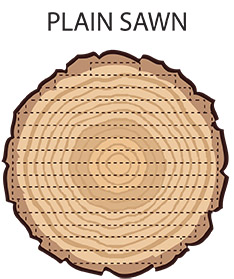Quarter sawn hardwoods are beautiful and distinctive. The unique look of quarter sawn hardwoods lend itself to an array of design styles, from traditional to modern.
But, when designing with solid quarter sawn hardwoods, it is important to understand how the uniqueness of this wood comes with a limitation in product width.
Why Is Quarter Sawn Lumber Narrow?
In order to obtain the distinctive straight-grained appearance of quarter sawn lumber, logs must be sawn in a different way. The log is first cut in half and then into halves again. After being cut into quarters, each quarter section is placed on the mill in a position so that the annual rings are as close to 90 degrees (perpendicular) to the face of each board as possible when sawn.
By sawing the log in this way, quarter sawn lumber yields more waste and therefore the end result is narrower boards, in comparison to plain sawn lumber sawing methods.


Why is Quarter Sawn Hardwood More Expensive?
Quarter sawn hardwood can command a premium over plain sawn lumber. This is primarily due to a more limited availability of quarter sawn lumber – both because of the lower number of boards made from each log and combined with a much smaller number of suppliers producing this kind of lumber. This limited availability of quarter sawn lumber results in a premium price for this type of lumber.
Is Quarter Sawn Hardwood Worth It?
The principal benefit of the quarter-sawing technique is that all of the grain will be straight, resulting in a more dimensionally stable product. Quarter sawn lumber typically does not warp, twist, or cup. A narrow grain pattern is typically evident on the face of the board. Flecks are generally evident in quarter sawn red oak and white oak, but can also be seen in other species. Read more about quarter sawn wood.
Is Quarter Sawn Wood Still A Green Choice?
Many have asked whether the higher waste involved in making quarter sawn wood result in a product that is less environmentally friendly than traditional lumber. The answer is simple – quarter sawn wood is a sound environmental choice. (Read more on why solid wood is a great design choice for our environment.) Companies who produce quarter sawn lumber use the rest of the log in a variety of ways. Bark can be turned into mulch and wood chips supply paper companies, while sawdust is often used on-site to fuel drying kilns. No part of the log is left unused.

